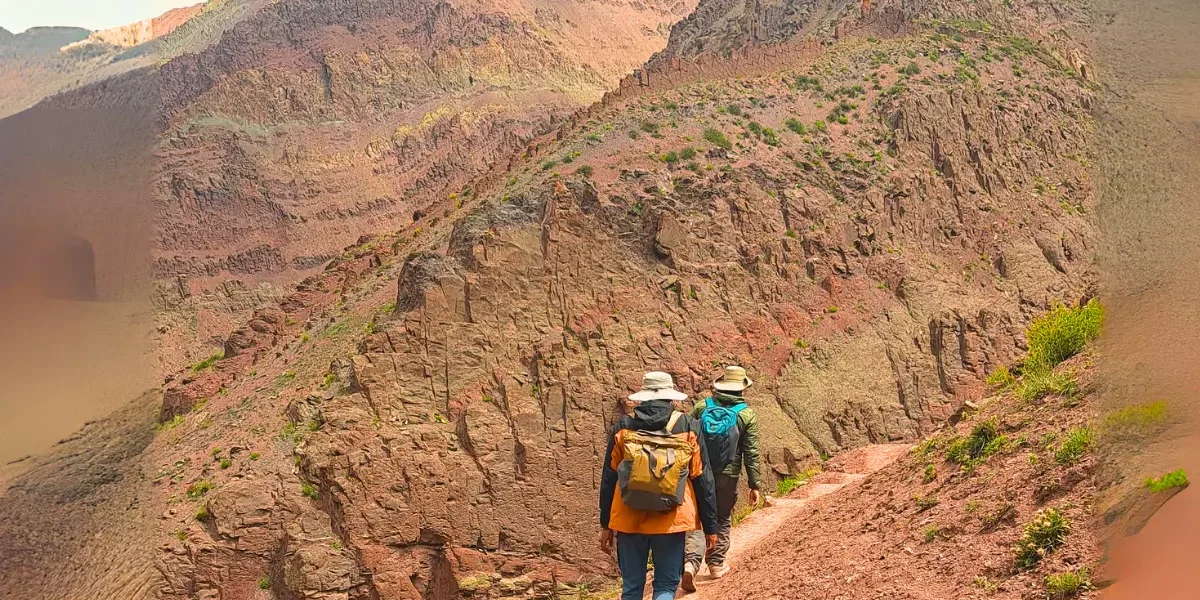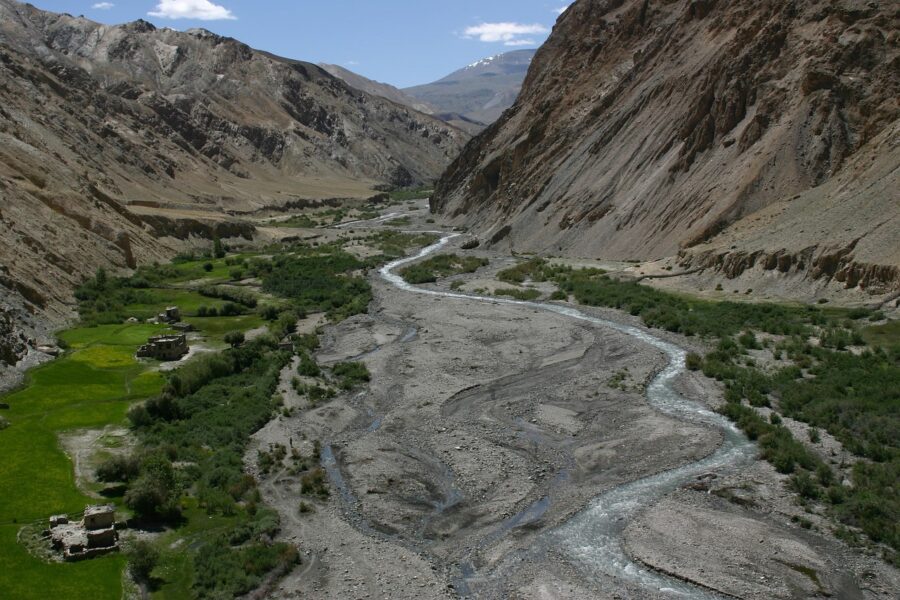Where the Valley Teaches You to Breathe Again
By Declan P. O’Connor
Introduction — Why Markha Valley Still Matters in an Accelerated World
The quiet defiance of slow landscapes
There is a particular silence that settles over you when the plane touches down in Leh. It is not the absence of sound; the airport is busy enough, the taxis are waiting, the horns still exist. But beneath the noise there is a slowing, a subtle insistence that the world will not move any faster than the thin air allows.
For many European travelers, the journey to Ladakh begins in a sequence of familiar hubs — Paris, Frankfurt, Milan, Madrid — polished terminals designed for efficiency and speed. The connection to Leh is something else: a short hop that feels like a long step out of the logic that has shaped most of our days. The Markha Valley trek, especially in its classic seven-day form from Skiu to Chokdo, builds on that step and turns it into a complete re-orientation of pace, attention, and expectation.
This is not a trek designed for instant gratification. You will not rush from highlight to highlight as if crossing items off a digital checklist. Instead, you climb slowly from 3,500 meters in Leh to the 5,200-meter pass at Kongmaru La, brushing against the limits of your lungs and your habits at the same time. The itinerary — arrival and acclimatization in Leh, a gradual approach via Skiu and Sara, then deeper into Markha, Hankar, Nimaling, and finally Chokdo — is more than logistics; it is a curriculum. Each day teaches you how to inhabit your own body in a landscape that refuses to be minimized or compressed into a feed.
In an era where most journeys are mediated by screens and scored by notifications, the Markha Valley trek offers a different proposition. It invites you to walk long distances at a human pace, to feel every meter of altitude in your chest, to regard time not as something to be optimized but as a field to be crossed on foot. It is scenic, certainly — from willow-lined rivers to high, spacious meadows — but its deeper gift lies in how it asks you to live those seven days. Slowly. Deliberately. Awake.
How Ladakh resists the logic of speed and efficiency
Ladakh has always been a place of thresholds: between empires, between languages, between spiritual lineages, and now between the accelerating world and those pockets of resistance that quietly insist life can still be lived differently. When you look at Leh from the ridge paths above it, you can trace the new roads, guesthouses, and cafés that tie it into the circuits of global tourism. Yet beyond the last row of buildings, the land reasserts itself with an almost stubborn clarity: long valleys, sparse villages, and passes that can only be reached in hours of walking, not minutes of swiping.
The Markha Valley trek occupies this threshold. It is accessible — seven days, homestays available, the possibility to link it with ascents of Kang Yatse II or Dzo Jongo for those who want more technical challenges — but it is not tame. The altitude will not be negotiated with. Weather shifts without reference to your plans. A stream crossing will be too cold whether or not your trekking shoes are “quick-dry.” In this sense, the valley resists the idea that all experiences can be made seamless and convenient.
For travelers arriving from Europe, used to train timetables and well-signposted trails in the Alps or the Pyrenees, this resistance can be both unsettling and liberating. The Markha Valley trek asks you to hold two truths at once: that you are a guest in a fragile high-altitude ecosystem, and that not everything needs to be maximally efficient to be worthwhile. If anything, the very “inefficiencies” — acclimatization days, slower walking speeds, long ascents and descents — are what make the journey worth taking. In the quiet defiance of these slow landscapes, many people rediscover the kind of attention that urban life quietly erodes.
The Grammar of Altitude — What Thin Air Reveals
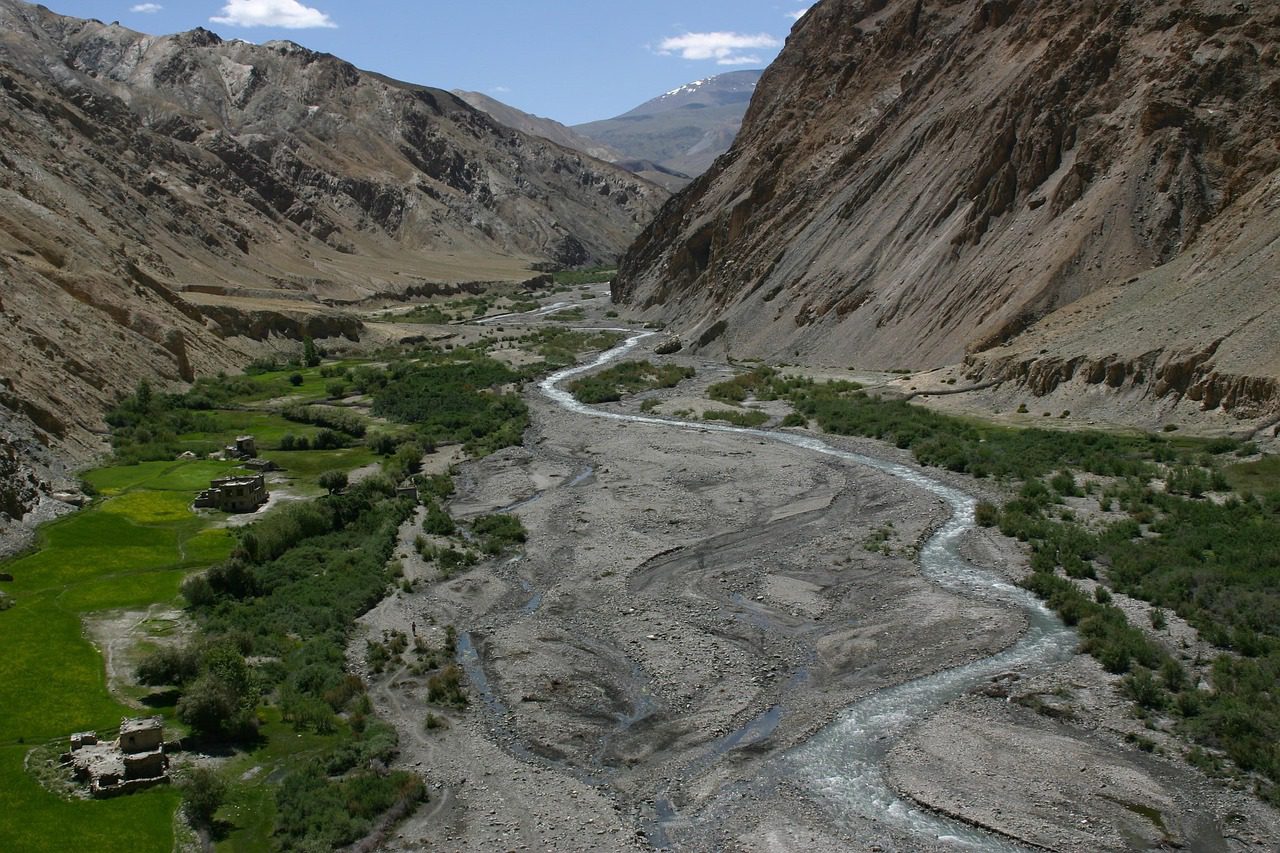
The moral clarity of high places
At around 3,500 meters in Leh, you begin to feel it: an honest resistance in your chest as your body argues with the altitude. On the Markha Valley trek, that resistance is not an obstacle to be hacked but a teacher to be listened to. High places have a way of reordering your priorities with a severity that can feel almost moral. At home, you can bluff your way through exhaustion with caffeine and deadlines; up here, the mountains are unmoved by your improvisations.
The grammar of altitude is simple and unforgiving. Walk too fast on your first day in Skiu or Sara, ignore the advice to hydrate and rest, and you will be corrected quickly: a dull headache, a heaviness in your legs, a shortening of breath that no motivational quote can resolve. Walk steadily, drink water, sleep early, and the same mountains become less hostile and more like stern but patient instructors. They reward humility and consistency, not bravado.
There is something clarifying about a world where consequences are this direct. Decisions have visible outcomes: the choice to spend two nights acclimatizing in Leh before the trek, the choice to ascend slowly towards Nimaling, the decision to turn back if symptoms worsen. In a culture often trained to ignore or outsource our limits, the Markha Valley trek offers a different ethic. It does not romanticize suffering. Instead, it quietly insists that listening to your own body — and to the land itself — is not weakness but wisdom.
Why discomfort becomes a teacher at 3,500 meters
Discomfort, in most of contemporary life, is treated as a glitch to be patched, a problem to be solved by better design. On a seven-day trek from Skiu to Chokdo, especially as you climb towards 4,800 meters at Nimaling and cross 5,200 meters at Kongmaru La, discomfort is unavoidable. The air is thinner. The nights are colder than you expected. Your backpack feels inexplicably heavier on the fourth or fifth day. No app can make your lungs work faster.
Yet it is precisely this discomfort that can become a teacher if you allow it. It reveals, first, how much of our supposed strength rests on artificial support systems — constant stimulation, perfectly controlled temperatures, immediate access to food and entertainment. Take those away for a week, and you discover what remains: the quiet stamina of your legs, the way your breathing can slowly adapt, the strange joy of a simple meal after a long ascent.
Many trekkers speak of a shift that happens somewhere between Markha and Hankar: a morning when the cold no longer feels like an affront but simply a fact, when the climb is demanding but not absurd, when your body has stopped protesting and started cooperating. Discomfort has done its work. It has stripped away some illusions and introduced you to a slower, truer sense of capability. You still respect the risk — altitude sickness remains a real concern — but you no longer interpret every difficulty as an injustice. In this way, the valley teaches a lesson that outlives the trek: some of the most valuable forms of growth arrive not in comfort, but through carefully chosen, attentively experienced difficulty.
Acclimatization as a spiritual discipline, not a medical protocol
Guides and doctors will tell you that acclimatization is essential in Ladakh. Spend at least one or two days in Leh at 3,500 meters, walk slowly, avoid alcohol, drink water. These are sound medical instructions, and anyone planning the Markha Valley trek should take them seriously. But there is another dimension to acclimatization that often goes unspoken: it is also a kind of spiritual discipline, a small rebellion against our impatience.
To acclimatize is to submit to a pace that is not your own. It means saying no to the familiar temptation to compress experiences into the shortest possible timeframe. On Day 1 and Day 2 in Leh, you could try to rush — to tick off every monastery, to squeeze in a downhill cycling tour, to make every hour “productive.” Or you could treat these days as an invitation to re-learn idleness: to sit in a courtyard at Thiksey Monastery and watch the light shift on the mountains, to walk slowly through the bazaar, to allow your body to catch up with your itinerary.
In this sense, acclimatization is more than preparation for altitude; it is rehearsal for a different way of being. The Markha Valley trek does not reward those who arrive with an agenda to dominate the trail. It honors those who are willing to listen — to their guides, to the weather, to the quiet signals of their own bodies. To acclimatize is to practice listening before speaking, waiting before acting. It may be the most countercultural part of the journey for a traveler conditioned by cheap flights and tight schedules. And yet, without it, the rest of the trek rests on fragile ground.
Entering the Valley — From Leh to the First Steps at Skiu
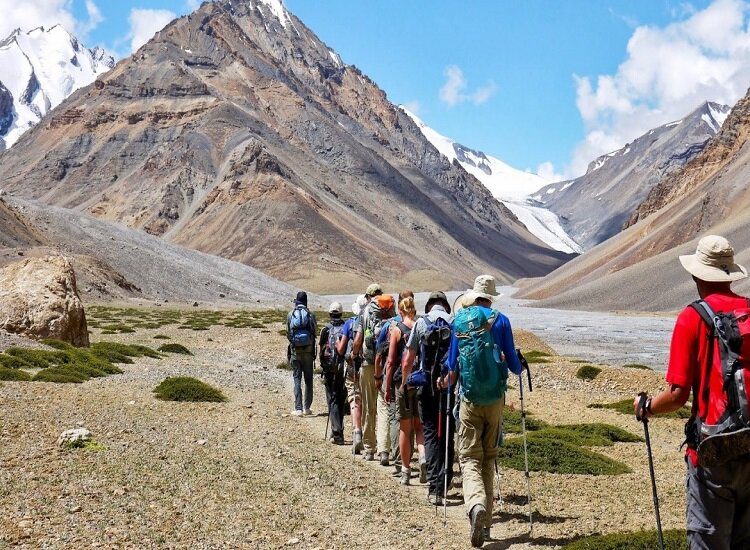
The cultural threshold between city rhythms and mountain time
The drive from Leh to Skiu is not particularly long in kilometers — roughly 70, covered in a few hours — but it spans a larger distance in mood. The road follows the Indus, slides past familiar names on the Ladakh travel map: Shey, Thiksey, the confluence at Sangam, the turn-offs to Hemis. Many travelers will have visited some of these places during their acclimatization days. Yet as the vehicle continues, the density of houses thins, and a different register of time begins to announce itself.
In Leh, even at altitude, there is still the sense of a small city trying to keep up with the world: cafés with Wi-Fi, shops with trekking gear imported from Europe and Delhi, conversations in multiple languages. By the time you reach the trailhead at Skiu, that world feels one valley away. The Markha River cuts a different path, and the villages that cling to its banks operate on older rhythms. Fields are irrigated not by schedules but by meltwater and season; animals are moved according to grazing cycles, not to weekends.
Your first steps on the trail are, in this sense, ceremonial. You leave behind not just the road but an entire set of expectations about urgency. The village paths, the mani walls, the shrines at the edge of settlements — these do not exist to entertain you, and they do not adjust themselves to your deadlines. At Sara, your first night on the trail, you notice how the day narrows down to a few essentials: walking, eating, resting, talking briefly with your hosts. The simplicity is not empty; it is full of the small details you finally have time to notice.
The drive to Skiu as a slow detachment from modern certainty
There is a temptation, especially for experienced trekkers from Europe, to treat the transfer from Leh to Skiu as a mere logistical step: a drive to endure before the “real” trek begins. But to think this way is to miss one of the subtler offerings of the Markha Valley route. The road itself is a kind of decompression chamber between familiar modern certainties and the more ambiguous terrain of the mountains.
On the highway out of Leh, your phone may still catch a signal; you might answer a last message or check the weather forecast for the days ahead. But as the vehicle follows the narrower road to Skiu, even these fragile threads begin to fray. The conversation shifts from emails and itineraries to more elemental questions: how are you feeling at this altitude? What do you expect from the next seven days? Do you understand what it means to be walking between 3,400 and over 5,000 meters?
Somewhere along that road, the logic of safety changes. At home, security might mean insurance, backup plans, and emergency numbers. Here, it also means listening to your guide, respecting the line between ambition and recklessness, accepting that the weather and your own body may overrule your plans. The drive to Skiu is not dramatic, but it quietly ushers you into this new logic. When you finally shoulder your backpack and step onto the trail, you are no longer a tourist hopping between attractions; you are a walker entering a landscape on its own terms.
The First Movements of the Trek — Sara and the Meaning of Small Distances
Why early kilometers matter more than summit distances
When people speak about the Markha Valley trek, they often highlight the big numbers: the 5,200-meter pass at Kongmaru La, the long ascent to Nimaling, the total distance covered over seven days. But in practice, what shapes your experience most profoundly are the early kilometers — the first 11 from Skiu to Sara, the next 10 towards Markha. These are the stages where habits are formed, where your relationship with the trail is established.
On paper, the day from Skiu to Sara does not look intimidating: a gentle gain from around 3,400 to 3,600 meters, a walk of five to six hours along the valley. Yet it is here that your body decides how it will respond to the week ahead. If you push too hard, trying to turn the day into an athletic performance, you may pay for it later. If you move steadily, pausing for water and to watch the river unravel below the path, you begin to align yourself with the terrain.
These early kilometers also recalibrate your sense of achievement. In much of life, we have been trained to chase visible peaks — promotions, metrics, completed projects. On the trail to Sara, the successes are smaller and more quietly satisfying: a rhythm of breathing that no longer stumbles, a growing lightness in your steps as your legs remember what they were made for, the way the anxiety of departure begins to thin out in the clarity of the valley air. By the time you reach your homestay or camp, you have not “conquered” anything. You have begun something, and that beginning matters more than any summit photo you might one day frame.
Learning the valley’s pace: patience, hydration, breath
There are three simple disciplines that quietly govern the Markha Valley trek: patience, hydration, and breath. None of them are glamorous. They will not appear in social media captions. Yet without them, the journey from Skiu to Chokdo becomes harder than it needs to be. The first full days on the trail — Skiu to Sara, Sara to Markha — are where you learn these disciplines or ignore them.
Patience means accepting that the landscape will not hurry for you. The trail may wind in long, seemingly unnecessary arcs. A section that looks “close” across the river can take an hour to reach. The village you have been watching in the distance seems to remain at the same size no matter how many steps you take. To push against this, to demand constant progress, is to invite frustration. To accept it is to discover a kind of freedom: you are no longer measuring your worth by speed.
Hydration, meanwhile, is the most basic expression of respect for your body at altitude. Drinking regularly feels boring compared to the drama of high mountains, but it is precisely this unromantic discipline that keeps headaches at bay and energy levels stable. Breath, finally, is both physiological and symbolic. You learn to sync your steps to your inhalations and exhalations. You discover that a slower, deeper breath carries you further than any burst of speed. In a world that celebrates acceleration, these lessons might be the most radical thing the valley teaches.
Markha Village — A Study in Resilient Community

What traditional villages reveal about scarcity and generosity
When you reach Markha village on the fourth day, you are no longer merely visiting the valley; you are living inside its logic. The fields, stone houses, and monasteries are not scenic backdrops; they are the infrastructure of a community that has learned how to endure in a place where every resource is negotiated with altitude and season. For travelers from European cities, where abundance is assumed and scarcity is an exception, this encounter can be quietly disorienting.
Water here is not a given. It is channeled through irrigation channels, shared according to longstanding agreements. Food is not an endless buffet but the product of months of labor. The wood that warms the stove in the corner of the kitchen did not arrive wrapped in plastic; it was gathered, carried, stored. In such a context, generosity acquires a different weight. When your hosts pour you an extra cup of tea or offer a second helping of dal and rice, it is not the performance of hospitality on an expense account. It is a decision made against the backdrop of real limits.
High-altitude kindness, you begin to realize, is not sentimental. It is a deliberate choice to share, again and again, in a world that rarely guarantees tomorrow’s abundance.
To stay in a homestay in Markha is to witness this choice up close. You see it in the way families balance the income from trekkers with the ongoing demands of their own lives, in the way children move between helping in the fields and curiously observing guests from faraway cities. The Markha Valley trek offers many scenic moments, but perhaps its most important view is this: a functioning community that has woven scarcity and generosity into a single fabric rather than holding them in opposition.
Walking among mani walls, barley fields, and river crossings
The day spent in and around Markha is generous in textures. You walk past mani walls carved with prayers that have outlived the empires which once claimed these valleys. Barley fields sway in the high-altitude breeze, their green a quiet rebuttal to the idea that this is a barren land. The river, sometimes crossed on makeshift bridges, sometimes waded through when the water is low enough, loops the path into a sequence of crossings that feel almost ritual.
For the European walker, accustomed perhaps to well-signed alpine routes and sturdy infrastructure, these crossings offer a different kind of engagement. They require attention — to the strength of the current, to the placement of your feet, to the state of your boots. They remind you that walking here is a negotiated act, not a given. At the same time, the presence of mani walls and chortens along the trail suggests that you are moving through a landscape that has been walked with reverence long before the idea of a “trekking season” existed.
As you move between the sacred and the practical — between prayer stones and irrigation channels, between fields and footpaths — the category of “scenery” begins to feel inadequate. The Markha Valley trek from Skiu to Chokdo is not simply a sequence of beautiful views; it is an introduction to a way of inhabiting place. The farther you walk, the harder it becomes to maintain the illusion that landscapes exist primarily for our consumption. They are living, working, and praying spaces first; we pass through as guests.
Hankar to Nimaling — Confronting the Spaciousness of High Altitude
When landscape becomes a moral invitation
The route from Markha to Hankar and then to Nimaling is where the valley begins to open in earnest. The villages thin out. The river crossings become fewer, the paths steeper. At Hankar, you already sense that you are approaching a different order of altitude; by the time you reach Nimaling at around 4,800 meters, you are walking in a high, exposed amphitheater of rock, sky, and wind.
In such spaces, the landscape no longer feels like a backdrop. It behaves more like an invitation — or, at times, a demand. The vastness pushes back against the small, tidy ways we often think about our lives. Standing in Nimaling, with the peaks of Kang Yatse rising nearby and the route to Kongmaru La etched somewhere in the scree ahead, you may find that your usual mental preoccupations simply do not fit. The concerns that dominated your days in the office or on the metro at home shrink against the scale of the ridge lines.
This is not about romanticizing mountains as inherently virtuous. Rock and ice have no moral agenda. But they do create conditions under which certain kinds of reflection become harder to avoid. Questions about what you are doing with your time, how you handle responsibility, what you owe to others and to the fragile places you visit — all of these can surface more sharply in the spaciousness of high altitude. The Markha Valley trek, in its middle days, becomes less about getting to the next campsite and more about deciding who you are in a place that does not need you but permits you to pass.
The psychology of climbing toward 4,800 meters
From a psychological perspective, the climb toward Nimaling is a study in recalibrating expectations. You know, intellectually, that you are moving from lower villages toward a high camp; you have seen the numbers on the itinerary: 4,100 meters at Hankar, 4,800 at Nimaling. But numbers feel abstract until each step costs a little more effort, until conversations grow shorter as breath becomes more precious.
Many trekkers experience a curious mix of vulnerability and strength during this phase. On the one hand, you are acutely aware of your limits. Sleep may be lighter. Appetite might fluctuate. You notice every change in weather with a seriousness that city life rarely demands. On the other hand, you have already walked for several days. Your legs are strong in a way they were not in Leh. You have learned how to pack your bag, how to adjust your layers when the wind picks up, how to read the expressions on your guide’s face.
This combination — of acknowledged fragility and earned competence — can be profoundly instructive. It undercuts the illusion that strength means invulnerability. Instead, it suggests that true resilience looks like this: the willingness to move carefully through a demanding environment, fully aware of the risks, yet ready to continue because you have prepared well and are not alone. As you approach Nimaling, with its wide meadows and often restless weather, you carry this lesson as surely as you carry your pack.
Kongmaru La — A Pass That Judges Your Intentions
Why every high pass is a conversation between will and humility
The morning you leave Nimaling for Kongmaru La feels different. Even if you have crossed high passes before in the Alps or the Caucasus, there is a certain quiet that settles over the group. At 5,200 meters, Kongmaru La is not a technical climb, but it is high enough that every breath is a small negotiation. The path ahead is usually clear — a series of switchbacks, a steady rise — yet it is not the kind of ascent you tackle casually.
High passes do not care about your résumé or your equipment brand. They respond to simpler realities: how well you acclimatized, how honestly you walked the preceding days, whether you are willing to adjust your plans if your body protests. In this sense, the climb to Kongmaru La becomes a conversation between your will and your humility. Determination is necessary; without it, you would not wake up in the cold pre-dawn light and begin walking. But determination without humility — the kind that ignores symptoms or pushes others beyond their capacity — can be dangerous here.
As you climb, you may find your world narrowing to a sequence of small goals: the next bend, the next rock, the group resting point above. This narrowing is not failure; it is exactly the right strategy. When finally you reach the pass, prayer flags snapping in the wind, the view opening towards new valleys and distant ridges, there is no need for grand declarations. The pass has already judged your intentions in a more honest way: did you walk with respect, did you listen to your own limits and those of others, did you treat the land as a place to be received rather than conquered?
The slow descent to Chokdo as a lesson in letting go
Many treks treat the summit or the pass as the climax of the story, with the descent reduced to an afterthought. The Markha Valley trek, however, insists that the way down from Kongmaru La to Chokdo — and eventually back to Leh — is a chapter in its own right. The long descent, often through sections of gorge, across shifting paths and streams, teaches a different kind of discipline.
Going down requires its own form of restraint. Knees and ankles, grateful for the easier breathing, now absorb the impact of hours of steps. It can be tempting to rush, to let gravity pull you back toward lower altitudes and the comforts of hot showers and soft beds. Yet the terrain demands continued attention. A careless foot on loose gravel, a moment’s inattention at a stream crossing, can undo the careful work of the previous days.
Psychologically, the descent to Chokdo is also the beginning of letting go. You are leaving behind the high meadows of Nimaling, the concentrated clarity of the pass, and re-entering a world with more options and distractions. The village paths widen into roads; eventually a vehicle will carry you the remaining distance back to Leh. If you are attentive, you can use these hours not just to replay achievements but to ask a quieter question: what, exactly, do you want to bring back from the valley into the rest of your life? The answer rarely appears in words. It settles instead as a new sensitivity to pace, a less frantic relationship to time and difficulty.
The Valley After the Valley — Returning to Leh Changed
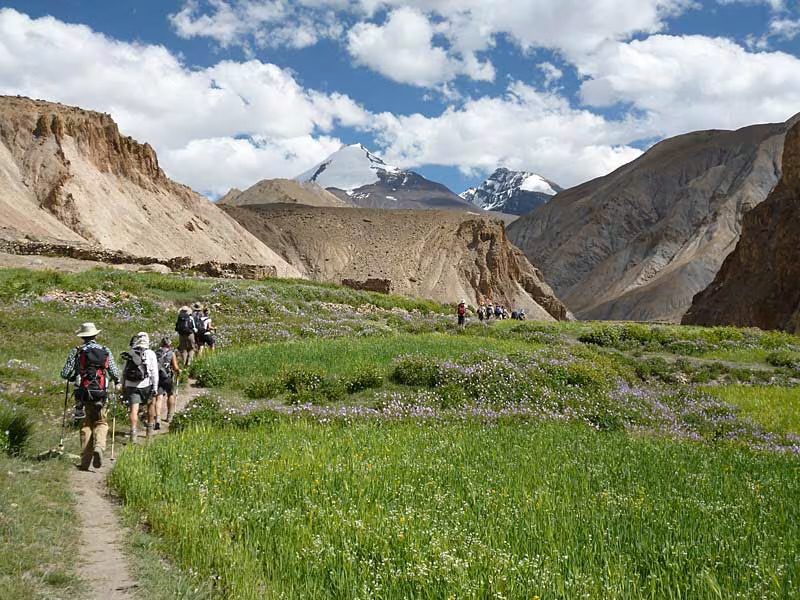
Why the descent often transforms more than the ascent
When you arrive back in Leh after the drive from Chokdo, the town feels at once familiar and altered. The cafés are still there, the bakeries, the souvenir stalls. Yet you move through them differently. The Markha Valley trek has rearranged something in your internal landscape, and the descent — often overlooked — is where that rearrangement took shape.
Ascents tend to be future-oriented. You look up, think about the pass or the next village, imagine the view. Descents, by contrast, are strangely retrospective. Each step down from Kongmaru La, each kilometer closer to Chokdo, offers a chance to revisit the path you have taken — not just in the last week but in the last years. Many walkers report that their clearest insights during the trek arrive not on the way up but on the way down, when the pressure of “getting there” has eased and the mind can wander more freely.
Back in Leh, surrounded again by conversations, menus, and Wi-Fi signals, you may find that some of these insights feel awkwardly large for your ordinary routines. Perhaps your tolerance for trivial complaints has dropped. Perhaps you notice how much of your day at home is spent avoiding small discomforts that, in the valley, you simply accepted. The transformation is subtle, not revolutionary. The Markha Valley does not send you back as a different person overnight. It does, however, make it harder to pretend that you are unaffected by the way you move through the world.
The quiet re-entry into ordinary life after extraordinary altitude
Re-entry is an art rarely discussed in trekking brochures. After a week structured by clear tasks — walk, eat, rest, repeat — the loose complexity of everyday life can feel oddly harder. Emails, deadlines, domestic responsibilities, and social expectations all rush back in, eager to reclaim their old territory. The temptation is to treat the Markha Valley trek as a sealed memory: a folder of photos, a story to be told a few times and then filed away.
There is another option. You can treat the trek not as an escape but as a reference point. When a week seems impossibly busy, you might remember the long climb toward Nimaling and how you learned to take it in small segments. When a minor inconvenience feels intolerable, you might recall that evening in Markha when you were grateful for simple food and a warm room at the end of a cold day. These are not sentimental comparisons; they are practical calibrations.
The quiet re-entry after an extraordinary journey is where its real implications surface. If you let it, the Markha Valley trek from Skiu to Chokdo can become a lens through which you examine the pace and priorities of your life in Europe. It does not dictate answers. It simply reminds you that another rhythm is possible — one where breath, attention, and community are not afterthoughts but foundations.
Practical Notes for Readers (Without Breaking the Narrative)
Altitude highlights: 3,500 m to 5,200 m
The Markha Valley trek is often described as “moderate,” but this label can be misleading for those who underestimate altitude. From a European perspective, used to mountain ranges where 2,500–3,000 meters already feel high, the numbers in Ladakh demand respect. Leh sits at around 3,500 meters; Skiu and Sara are not much lower. As you move through Markha and Hankar and climb toward Nimaling at 4,800 meters, you are operating in an environment that requires steady preparation.
The highest point of the trek, Kongmaru La at about 5,200 meters, is not technical but is physiologically significant. Plan to spend two nights in Leh before starting, giving your body time to adapt. Walk slowly on the first days from Skiu to Sara and from Sara to Markha. Drink water frequently, avoid alcohol and heavy meals at first, and be honest about any symptoms: persistent headaches, dizziness, or nausea should not be ignored. This is not alarmism; it is respect for the realities of high-altitude travel.
For those who feel strong at these elevations and are seeking further challenge, the region offers the possibility of linking the trek with ascents of peaks such as Kang Yatse II or Dzo Jongo, often planned as separate expeditions. Even then, the Markha Valley route remains a wise foundation: it allows you to build acclimatization gradually while experiencing one of Ladakh’s most storied valleys in depth.
Suggested acclimatization days
A well-planned Markha Valley trek begins before you ever set foot in Skiu. At minimum, set aside two full days in Leh for acclimatization. Use the first to rest from travel, walk gently through the town, and let your body register the new altitude. On the second, you can explore nearby monasteries — Shey, Thiksey, Hemis, or the confluence at Sangam — but keep the exertion moderate. The goal is not to see everything; it is to arrive well in your own skin.
Some travelers, especially those coming directly from sea-level cities like Amsterdam, Copenhagen, or Lisbon, may benefit from an extra day. This is not wasted time. It is an investment that often makes the difference between a trek enjoyed and a trek endured. Consider using these days to review your equipment, adjust your backpack, and mentally rehearse the rhythm of the journey: seven days of walking, rising and sleeping early, living with less but feeling more.
If your schedule and budget allow, you might also combine acclimatization with a gentle activity such as a short walk above Leh or a downhill cycling tour that does not overtax your system. The key is to move, breathe, and rest without pushing yourself into exhaustion. Acclimatization is not a bureaucratic hurdle; it is the first chapter of the story you are writing in the Markha Valley.
Why the trek pairs well with Kang Yatse II or Dzo Jongo
For experienced trekkers and aspiring mountaineers, the Markha Valley route from Skiu to Chokdo can serve as more than a standalone journey. Its progression — from 3,500 meters in Leh to 4,800 meters at Nimaling and 5,200 at Kongmaru La — makes it an excellent acclimatization platform for nearby peaks such as Kang Yatse II or Dzo Jongo. These mountains, while requiring additional days, specialized equipment, and qualified guides, draw on the acclimatization and stamina you have already built in the valley.
The advantage of this pairing is twofold. Physically, your body arrives at base camp already adapted to high altitude, increasing your chances of a safe and successful ascent. Psychologically, you have spent a week learning how you respond to fatigue, changing weather, and the subtle pressures of thin air. You are not guessing at your capacity; you have tested it in real conditions. For many, this makes the step from trekking to non-technical mountaineering more grounded and less impulsive.
At the same time, it is important not to let summit ambitions overshadow the valley itself. The Markha route is not merely a warm-up act. Its villages, fields, and passes are worthy of attention in their own right. If you choose to extend your journey to a peak like Kang Yatse II or Dzo Jongo, treat the trek as a chapter that deserves its own full reading, not only as a prologue to a summit photo. The mountains will still be there. The question is how you choose to meet them.
Conclusion — What the Markha Valley Asks of the Modern Traveler
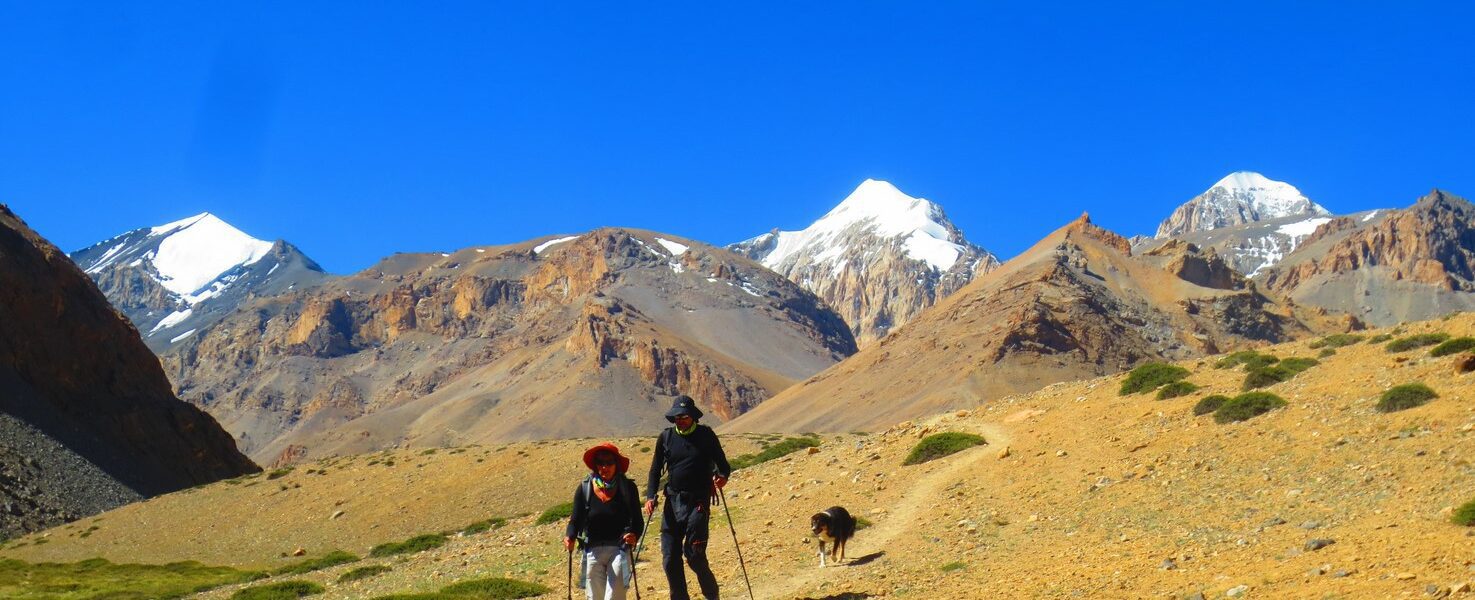
The ethic of slowness in an age of acceleration
By the time you have walked from Skiu to Chokdo, crossed the pass at Kongmaru La, and returned to Leh, the Markha Valley trek has asked you many questions in the language of altitude, distance, and time. None of them are complicated. All of them resist easy shortcuts. At its heart, the valley poses a simple challenge to the modern traveler: can you accept a week of slowness in an age that equates value with speed?
Slowness here is not passive. It does not mean idleness or drifting. It looks like steady footsteps on a long ascent, conversations unhurried by constant checking of the time, evenings spent watching the light fade over barley fields instead of scrolling through another feed. It looks like planning your days around the weather and your body rather than around meeting invitations. It is hard work, but of a different kind than many of us practice at home.
If you allow it, the Markha Valley trek can become an embodied argument against the assumption that faster is always better. The scenic journey from Skiu to Chokdo is beautiful — no one who has crossed Nimaling or stood at Kongmaru La would deny that — but its deeper beauty lies in how it reorders your relationship to time. Seven days is not long in the scale of a life. Yet lived with attention, those days can linger, quietly shaping your choices long after your boots have been cleaned and your backpack stored away.
How landscapes become teachers when we stop asking them to entertain us
There is a subtle but important shift that can occur on the Markha Valley trek if you let go of the expectation that landscapes exist primarily to entertain you. The valley, after all, is indifferent to your presence. The river does not flow differently because you have flown in from Rome or Brussels. The mountains do not adjust their gradients to match your fitness app.
When you stop asking the land to perform, something gentler opens up. You begin to notice how much knowledge is embedded in the paths, houses, and fields you pass. Mani walls mark not just religious devotion but long histories of people investing labor into stone in a place where time and weather erase careless work quickly. Irrigation channels speak of cooperation and planning. The arrangement of fields and grazing grounds tells you how precarious and ingenious high-altitude agriculture can be.
In this sense, the Markha Valley becomes less like a stage set and more like a set of teachers. They do not speak loudly. Their lessons arrive in sore muscles, in shared meals, in the hard clarity of cold mornings and the soft generosity of homestay stoves. For those willing to listen, the message is not mystical. It is practical and demanding: live more deliberately, respect your limits, honor the communities and ecosystems that allow you to pass through their space. The trek ends. The invitation does not.
FAQ — Practical Questions for the Markha Valley Trek
Q1: Is the 7-day Markha Valley trek suitable for beginners?
For a reasonably fit beginner who is prepared to train and acclimatize properly, the 7-day Markha Valley trek can be suitable. The paths are not technical, but the altitude is serious, so prior experience with long day walks and hiking in varied terrain is helpful. Think of it less as an extreme expedition and more as a demanding high-altitude journey that rewards patience, preparation, and honesty about your own limits.
Q2: When is the best season to do the Markha Valley trek from Skiu to Chokdo?
Most travelers walk the Markha Valley between late June and September, when passes are generally open and homestays or camps are operating. Early in the season you may encounter snow patches near Kongmaru La, while later months can be cooler at night but often more stable underfoot. Whatever the month, expect strong sun during the day, cold evenings, and the need for flexible layers rather than relying on a single “perfect” temperature.
Q3: Do I need a guide or can I trek independently?
Maps and GPS tracks exist, and experienced high-altitude hikers may be tempted to trek independently. However, a local guide brings more than route knowledge: they offer insight into village customs, help with homestay logistics, and monitor how you and your group are coping with the altitude. For most visitors, especially those coming directly from Europe with limited time, walking with a reputable local operator is both safer and far more enriching.
Q4: How does the Markha Valley compare to treks in the Alps or Pyrenees?
In the Alps or Pyrenees, you may walk at similar daily distances, but usually at significantly lower altitude and with denser infrastructure. The Markha Valley feels more remote, with higher passes, fewer settlement clusters, and a stronger sense of moving through living villages rather than purely recreational landscapes. The demands are less technical and more physiological and cultural: you must listen to your body and remember that you are moving through someone’s home, not just a playground.
Q5: What should I keep in mind to trek responsibly in Markha Valley?
Responsible trekking here begins with humility. Travel light, carry out your rubbish, and minimize plastic where possible. Respect homestay rules, dress modestly in villages, and avoid loud behavior in or near monasteries. Choose local operators who treat staff fairly and prioritize safety. Above all, recognize that your journey depends on fragile high-altitude ecosystems and resilient communities; gratitude, not entitlement, is the most appropriate attitude to pack.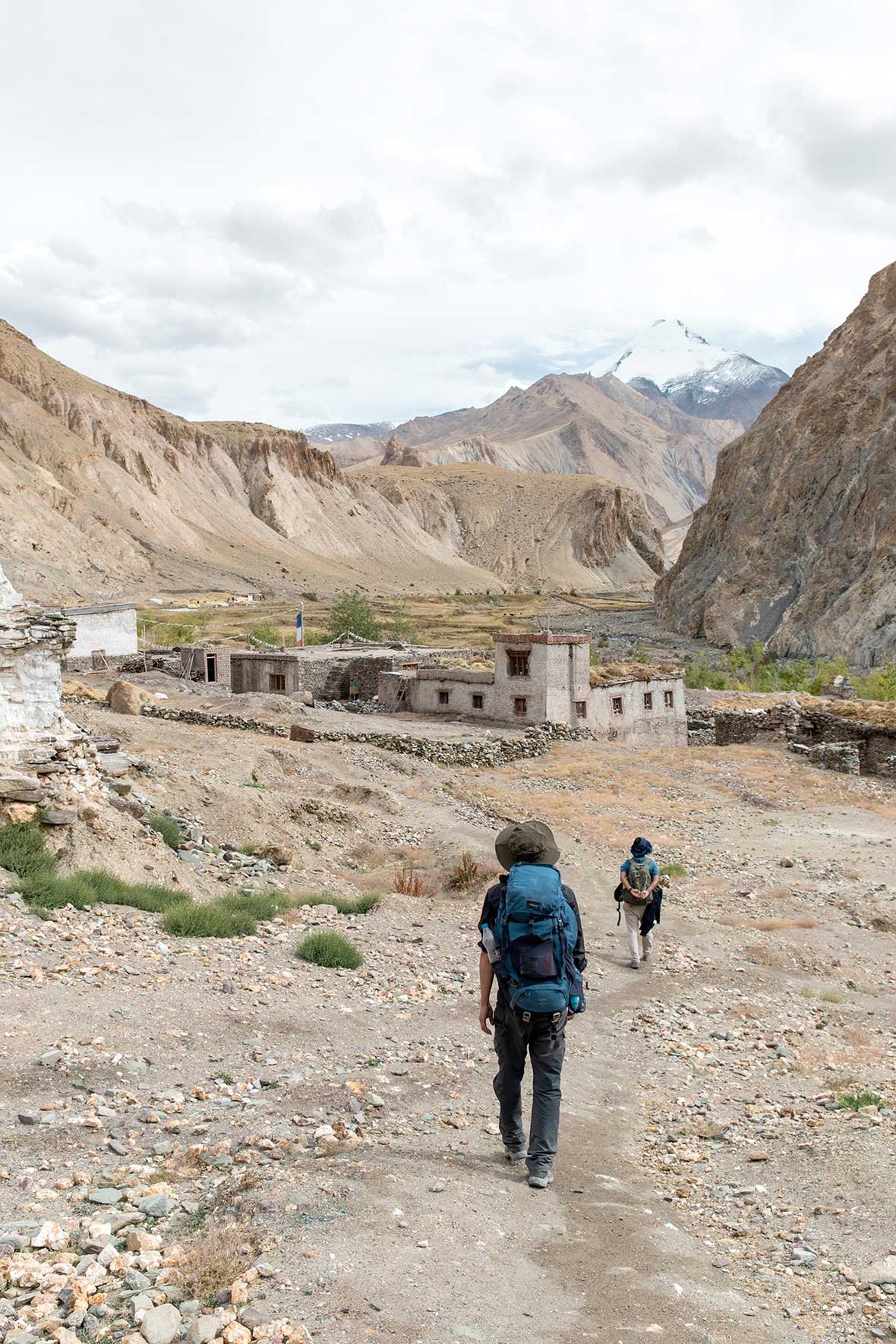
Closing note — carrying the valley home
The Markha Valley trek ends, as all journeys must, with a return ticket and a familiar skyline in Europe. Yet some part of your attention remains suspended above a river bend near Sara, in the dusty stillness of Markha’s fields at sunset, or in the cold, bright air of Kongmaru La. You may find that in difficult weeks, your mind drifts back there not as an escape but as a reminder of what you once managed with your own feet and breath.
To carry the valley home is not to idealize it or to pretend that life can permanently be lived at 4,800 meters. It is to remember that there are places in the world where time stretches, where community holds, and where effort and reward are still intimately linked. The seven days from Skiu to Chokdo will not answer every question, but they may nudge you gently toward better ones. And perhaps, when the noise of daily life grows too loud again, the memory of those thin-aired mornings will be enough to remind you: you once walked more slowly, more attentively, and the world did not fall apart. It became clearer.

